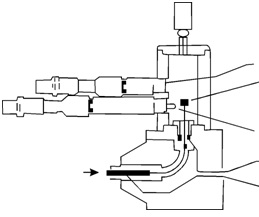Flame Emission Detector (Alkali Flame Detector):
The flame emission detector consists of a general flame detector plus further of a small alkali salt pellet placed at the burner set along with precise control of the hydrogen and air flow rates. This detector could be made to provide an enhanced response to phosphorus containing compounds. The three main differences among the standard FID and alkali flame detector are an alkali salt tip, the air flow rate and the electrode configuration. Both CsBr and Rb2SO4 have been used along with good results. These salts provide a selectivity of 5000 L for phosphorus and 50/L for nitrogen over general hydrocarbons. Alkali flame detectors operate at air flow rate of around 130 cm3/min that is significantly below that of a normal FID (300-400 cm3/min). Because constant air and hydrogen flow rates are significant for the stability of this detector, flow controllers are needs. The alkali flame detector has been used widely in the analysis of organo-phosphorus pesticides and for nitrogen containing solutes. The design of the detector is provided in Figure.

Figure: Alkali flame detector